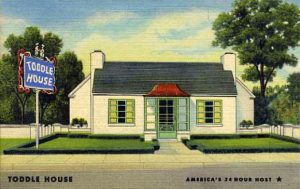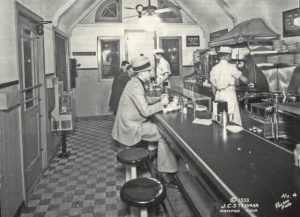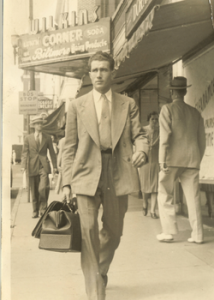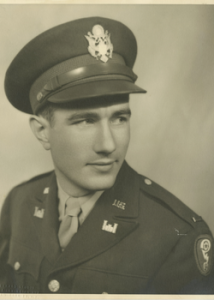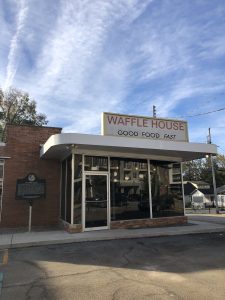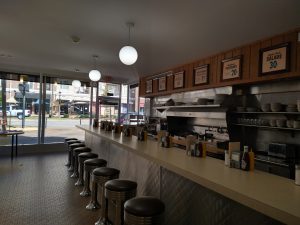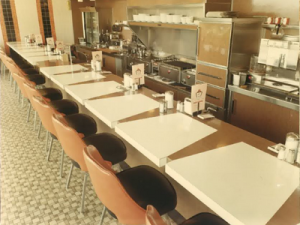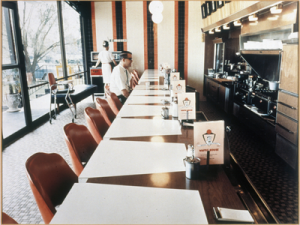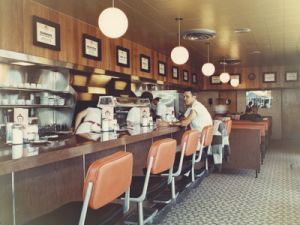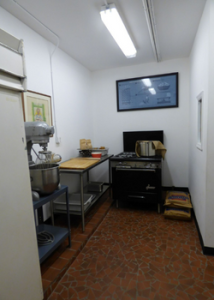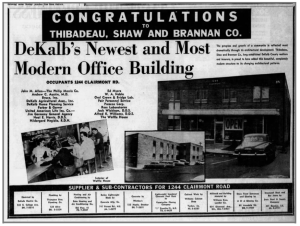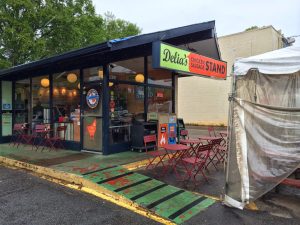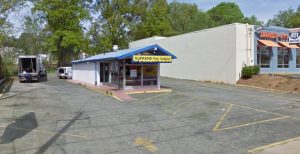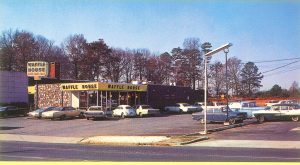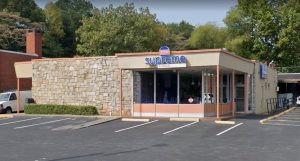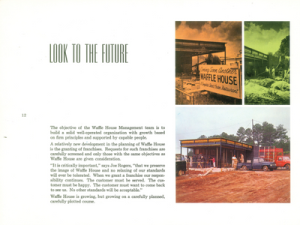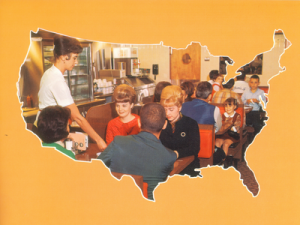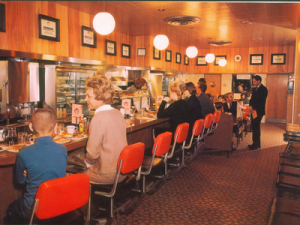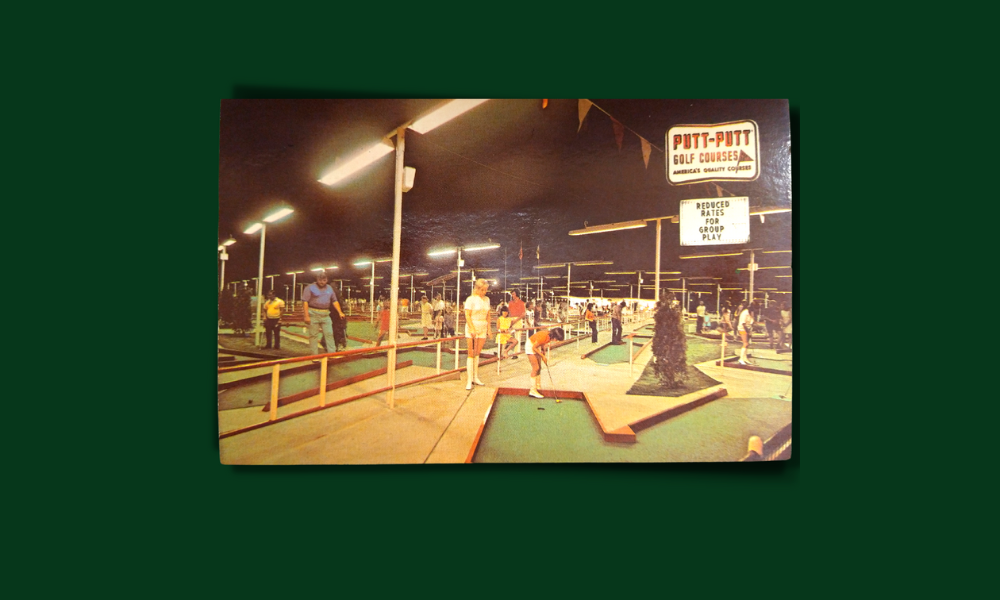Vintage Waffle House, History and Locations
Learn the history of Waffle House through vintage photos, and where the first several locations were. It might surprise you.
“We aren’t in the food business. We’re in the people business.” – Joe Rogers, Sr.
By Marissa Howard, Programs and Membership Coordinator
Blog updated 12-16-22
The Waffle House story began on Labor Day, in 1955, with the opening of the first Waffle House restaurant in Avondale Estates, Georgia.
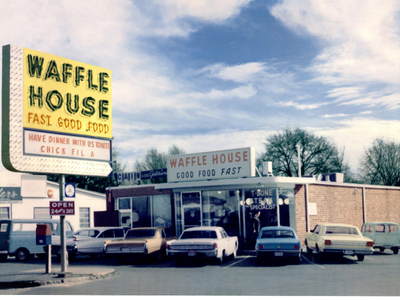
Unit #1 in Avondale Estates, ca. 1964. In the early days, in addition to its own menu, Waffle House served Chick-Fil-A sandwiches to customers. Today this location is the Waffle House Museum. Image courtesy of Waffle House Archives.
Co-founders and neighbors Joe Rogers, Sr., and Tom Forkner opened the restaurant as a 24-hour, sit-down establishment with people at the center of their philosophy.
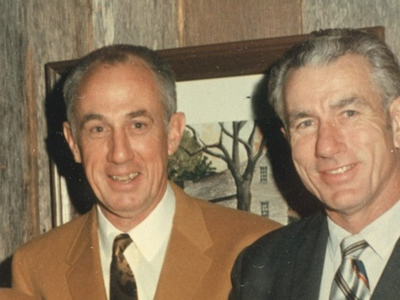
Joe Rogers, Sr., and Tom Forkner in the 1960s (L to R). Image courtesy of Waffle House Archives.
The two founders met and became friends in 1949 after Tom Forkner, who was in the real estate business, sold Joe Rogers, Sr., a home near his own in Avondale Estates.
The Founders
Joe Rogers, Sr., a former WWII flight instructor, left the military to go into the booming restaurant industry. In the 1950s, he became an executive with Toddle House, a 24-hour quick-service restaurant.
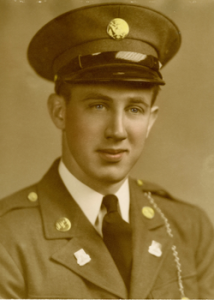
Joe Rogers, Sr., in his military uniform, 1940s. Image courtesy of Waffle House Archives.
At this time, Toddle House, and later Waffle House, were a relatively new concept in the Southeast. The diner was the predominant restaurant in the Northeast, with designs inspired by railroad or trolley cars. Known for quick and affordable service, these restaurants would serve eggs or burgers to hungry patrons any time of the day. The architecture of these earlier diners was Moderne, with flashy colors, streamlined details, and the unapologetic use of stainless steel. In the post WWII South, most quick restaurants’ menus and designs were focused around “home cooking,” and were not stand-alone structures. There were a few exceptions in the Atlanta area that could be considered diners including The Majestic Diner on Ponce de Leon Avenue.
The Toddle House, a Memphis chain, attempted to offer patrons in the South a “traditional” take on the diner concept. The restaurant was designed in the Colonial Revival style and evoked tradition on the outside, but its interior featured sleek stainless steel and fast service. Toddle Houses were small – only 10 customers could sit at a counter – and served hash browns, eggs, cheeseburgers, and pies; is this starting to sound familiar?
(L) Exterior of a Toddle House.
(R) Interior of a Toddle House, ca. 1933.
In 1955, Rogers was a division manager for Toddle House. While he enjoyed working there, he wanted to “create a fast-food operation that permitted him to reap some of the profits of his labor and efforts and to share stock ownership with his associates.” – Business and Security News, May 29, 1967.
____________
Tom Forkner, a WWII counterintelligence agent, returned to civilian life and joined his family’s real estate business in Avondale Estates. Tom’s father, Benjamin Forkner, helped develop Avondale Estates in the 1920s. By 1949, Forkner Realty was a thriving Avondale Estates real estate business and the city was a growing middle-class suburb accessed by several major roads.
(L) Tom Forkner in Asheville, North Carolina. Forkner Collection, DeKalb History Center.
(R) Tom Forkner, 1940s. Forkner Collection, DeKalb History Center.
Waffle House #1, Avondale Estates
A small office parcel at 2719 E. College Avenue, located between Avondale and Decatur, became available. By combining their $4,000 in savings, Forkner and Rogers were able to build-out a restaurant in that space and opened Waffle House #1 on Labor Day in 1955. At the end of the first year, the store had 10 employees and a sales volume of $50,000.
(L) Waffle House #1 is now a museum.
(R) Interior of the Waffle House Museum. It appears as it would have in 1955.
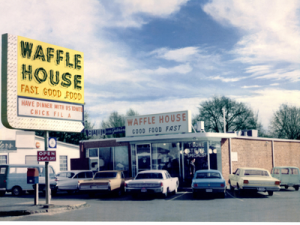
Unit #1 in Avondale Estates. Image Curtesy of Waffle House Museum.
The Waffle House Museum now occupies the flagship restaurant with the interior restored to its 1955 appearance. The interior design scheme combined the sleekness of the Toddle House kitchen with the warmth of wood paneling, which evoked a homey feel. The round pendant lights furthered softened the dining area.
(L-R) Interior of unknown Waffle Houses, 1960s. Images courtesy of Waffle House Archives.
Cleanliness was important, and the stores even featured “germ-resistant acoustic ceilings.” The equipment was all stainless steel to convey cleanliness and efficiency. The equipment was supplied by the Hotel and Restaurant Supply Company, the family business of the future founder of the Huddle House. By the late 1960’s, equipment design and installation company changed to the Hickman Company

Waffle House #11 in 1966. Located at 4966 Buford Highway in Chamblee, it was a Waffle House until 2011. Image courtesy of Waffle House Archives.
Waffle House aimed for unbeatable customer service and a genuine connection between the customers and employees. Waitresses and cooks operated across the counter, allowing for this connection. The bulk of prep was done behind the scenes in the commissary, allowing for quicker service up front.
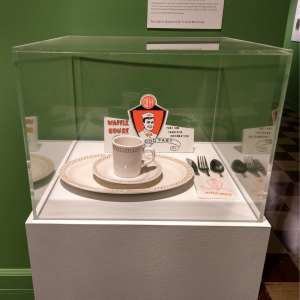
Waffle House Dishes, Silverware, and Menu Holder, 1960s. Although similar to the dishes in today’s Waffle Houses, this pattern has the classic 1960s “syrup covered” font also seen on the menu holder. The menu holder was made by the Clairmont Display company in Tucker, which is no longer in business. Associates were taught to place the silverware on the napkin. Items are on display at the DeKalb History Center, “200 Years of DeKalb” exhibit. Items on loan from Waffle House.
Waffle House #2, Midtown Atlanta
Opened in 1957, this location (originally called Wagon Wheel), was on the ground floor of the of Southern Bell Office building, located at 10th and Peachtree. The building now demolished, is now on the property of the Margaret Mitchell House.
___
Waffle House #3, Candler-Glenwood Shopping Center
Initially, there were no plans to expand beyond the first restaurant, but in 1958, a thirds location opened at 3198 Glenwood Rd in the Candler-Glenwood Shopping Center, a small strip mall on the corner of Candler and Glenwood Road.

Waffle House #3. Intersection of Candler-Glenwood Road. Who would have guessed the end unit of this small shopping center was Waffle House #3?
____
Waffle House #4, Clairmont Road
Their fourth restaurant opened in 1959 at the office building at 1244 Clairmont Road in Decatur. The building still exists.
(L) Ad from the Atlanta Constitution, October 21, 1959. Waffle House, with the OPEN sign in the window, on the first floor under the canopy.
(R) Former Waffle House location on Clairmont Road. The canopy was enclosed at a later date, concealing the original Waffle House exterior.
The first five locations were not the iconic freestanding yellow shoeboxes that we now associate with Waffle House; they were in multi-tenant settings like office buildings and shopping centers.
_____
Waffle House #5, Downtown Decatur
Waffle House #5 was located at 612 Church St.
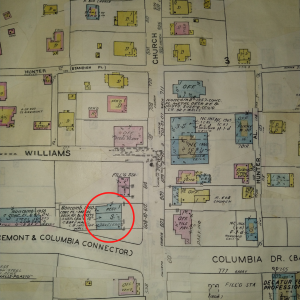
Our Sanborn Map shows the location of Decatur’s first Waffle House, circled in red. It was located at the intersection of what is now Commerce Drive and Church Street. The building was demolished for the access road into McDonald’s.
_____
Waffle House #6, 489 Moreland Avenue
The first standalone building (and sixth restaurant), was built by Avondale Estates contractor Paul Schulte on Moreland Avenue in East Atlanta; it operated as a Waffle House from 1961 to 1986. Tom Forkner also sold Schulte his Avondale Estates home. This design was unique with its A-frame roof and grey brick exterior.

Waffle House #6, the first standalone waffle house, was located at 489 Moreland Avenue in East Atlanta, ca. 1961. Image courtesy of Waffle House Archives.
Not yet the shoebox design, this location’s design is unique compared to subsequent Waffle Houses.
(L) Delia’s Chicken Sausage occupied this space from 2011-2022. The globe lights, although reminiscent of Waffle House, are not original.
(R) Supreme Fish Delight occupied the building from 1986-2011.
____
Waffle House #7, East Point
The familiar yellow color scheme and “shoebox” design appeared in 1962 in East Point at the restaurant’s seventh location, 1674 Washington St. The square shape of the “front of house” allowed the prep area behind the counter to expand and offered more seating, including booths. The original building is no longer there, but a new Waffle House still operates on the site.
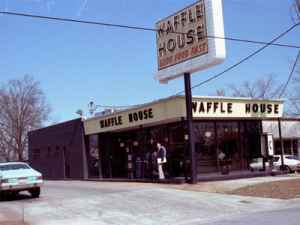
Location unknown, this 1970s Waffle House shows the shoebox design. The yellow roof overhang with poles is also typical of early designs.
____
Other early Waffle House Locations
(L) Waffle House, ca. 1966. 1827 Columbia Drive, Decatur.
(R) Today the building houses a Supreme Burger restaurant.

Waffle House at 1827 Columbia Drive. Image from “Story of Waffle House”
_____
By 1967, Waffle House was a $3,000,000 business with 25 franchises across three states.
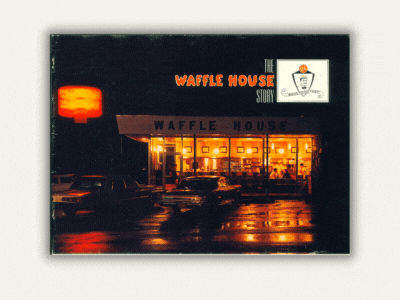
In the 1960s, Waffle House expanded rapidly through franchising. This booklet offered future owners a glimpse of the philosophy of Waffle House. Forkner Collection, DeKalb History Center.
Waffle House continues to provide customers with “Good Food Fast.” Today, there are over 1,900 units in 25 states. You can still visit unit #1 at the Waffle House Museum in Avondale Estates. And if after your visit you crave hash browns, you can dine across the street at Waffle House #1,000 in Avondale.
Many thanks to Waffle House and the Waffle House Archives for the images. You can visit the museum here: https://www.wafflehouse.com/museum/


